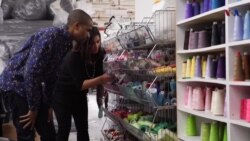In the late 19th to middle 20th century, America stood as the industrial powerhouse of the world. Consumers sought the latest American-made products, from cars to refrigerators to televisions.
US manufacturing in decline
But, things began to change in the late 1970s. Japan and China caught up with the U.S. in the production of many consumer goods. Today, China is a manufacturing powerhouse that produces about 80 percent of the world’s air conditioners, 70 percent of its mobile phones and 60 percent of its shoes. Chinese products represent almost half of all the goods made in the world.
And, now in the United States, it can be difficult to find a manufacturer to help develop a product.
Matthew Burnett knows this all too well. The American businessman started a watch company in 2007. At first, he had overseas manufacturers make all his products. But he often faced shipping delays, a lack of quality control, and time zone issues.
Later, he expanded into leather goods. Still, he struggled to find domestic factories to make the wallets, belts, and other products of his new brand.
And he was not alone. Many American entrepreneurs found it easier to go out of the country for manufacturing. There was no central marketplace for the industry.
Online marketplace
So, Matthew Burnett, and his business partner Tanya Menendez, created one. They called it Maker’s Row.
Since 2012, the online marketplace has been connecting entrepreneurs with American manufacturers.
“What we try to do at Maker’s Row is to encourage the brands to start producing in the United States so that you see more made in America products on the shelves," Burnett said. "We used to produce 97 percent of the apparel that we consume here in the United States, today it’s less than three percent. So it makes it very challenging to find sometimes made in America products, but that’s the narrative we’re trying to shift, by bringing these brands back home to produce.”
Makersrow.com also helps brands and businesses find and organize their supply chains.
A manufacturer pays a monthly fee to be listed on the site. It includes project planning software and a search feature. Manufacturers can also receive factory bids through the site.
For an additional cost, entrepreneurs get additional support.
Turning an idea into a business
Maker’s Row can be especially helpful to new or part-time entrepreneurs. The site can provide a plan for turning an idea into a business.
And co-founder Tanya Menendez says Maker’s Row offers classes and training.
“We have an online academy so people can take free online courses. They’re designed for people with busy lifestyles," Menendez said. "A lot of people that come to Maker’s Row start off working 9-to-5 and having this become like their side hustle so we cater to those entrepreneurs too and then we have project software where established businesses can organize all of their ideas in one place.”
Today, the Maker’s Row website has 80,000 registered users.
The registration and fee structure to access the site helps ensure the users are serious about their business, Menendez says.
The BCG company in Boston, which advises businesses around the world, estimates the average cost to manufacture goods in the U.S. is only five-percent higher than in China. And the company predicts that, by 2018, the cost difference will narrow further, to as little as two percent higher.
Maker’s Row and other similar efforts could play a big part in making that prediction come true.
This story was reported and produced by VOA's Learning English service.








